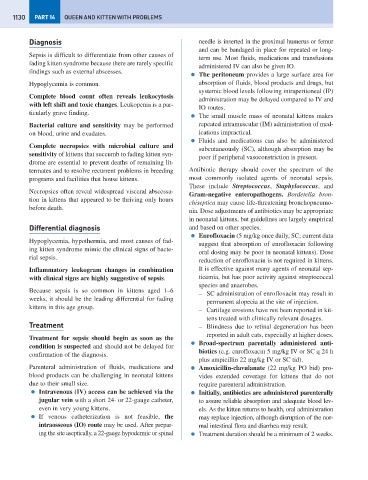Page 1138 - Problem-Based Feline Medicine
P. 1138
1130 PART 14 QUEEN AND KITTEN WITH PROBLEMS
Diagnosis needle is inserted in the proximal humerus or femur
and can be bandaged in place for repeated or long-
Sepsis is difficult to differentiate from other causes of
term use. Most fluids, medications and transfusions
fading kitten syndrome because there are rarely specific
administered IV can also be given IO.
findings such as external abscesses.
● The peritoneum provides a large surface area for
Hypoglycemia is common. absorption of fluids, blood products and drugs, but
systemic blood levels following intraperitoneal (IP)
Complete blood count often reveals leukocytosis
administration may be delayed compared to IV and
with left shift and toxic changes. Leukopenia is a par-
IO routes.
ticularly grave finding.
● The small muscle mass of neonatal kittens makes
Bacterial culture and sensitivity may be performed repeated intramuscular (IM) administration of med-
on blood, urine and exudates. ications impractical.
● Fluids and medications can also be administered
Complete necropsies with microbial culture and
subcutaneously (SC), although absorption may be
sensitivity of kittens that succumb to fading kitten syn-
poor if peripheral vasoconstriction is present.
drome are essential to prevent deaths of remaining lit-
termates and to resolve recurrent problems in breeding Antibiotic therapy should cover the spectrum of the
programs and facilities that house kittens. most commonly isolated agents of neonatal sepsis.
These include Streptococcus, Staphylococcus, and
Necropsies often reveal widespread visceral abscessa-
Gram-negative enteropathogens. Bordetella bron-
tion in kittens that appeared to be thriving only hours
chiseptica may cause life-threatening bronchopneumo-
before death.
nia. Dose adjustments of antibiotics may be appropriate
in neonatal kittens, but guidelines are largely empirical
Differential diagnosis and based on other species.
● Enrofloxacin (5 mg/kg once daily, SC; current data
Hypoglycemia, hypothermia, and most causes of fad-
suggest that absorption of enrofloxacin following
ing kitten syndrome mimic the clinical signs of bacte-
oral dosing may be poor in neonatal kittens). Dose
rial sepsis.
reduction of enrofloxacin is not required in kittens.
Inflammatory leukogram changes in combination It is effective against many agents of neonatal sep-
with clinical signs are highly suggestive of sepsis. ticemia, but has poor activity against streptococcal
species and anaerobes.
Because sepsis is so common in kittens aged 1–6
– SC administration of enrofloxacin may result in
weeks, it should be the leading differential for fading
permanent alopecia at the site of injection.
kittens in this age group.
– Cartilage erosions have not been reported in kit-
tens treated with clinically relevant dosages.
Treatment – Blindness due to retinal degeneration has been
reported in adult cats, especially at higher doses.
Treatment for sepsis should begin as soon as the
● Broad-spectrum parentally administered anti-
condition is suspected and should not be delayed for
biotics (e.g. enrofloxacin 5 mg/kg IV or SC q 24 h
confirmation of the diagnosis.
plus ampicillin 22 mg/kg IV or SC tid).
Parenteral administration of fluids, medications and ● Amoxicillin-clavulanate (22 mg/kg PO bid) pro-
blood products can be challenging in neonatal kittens vides extended coverage for kittens that do not
due to their small size. require parenteral administration.
● Intravenous (IV) access can be achieved via the ● Initially, antibiotics are administered parenterally
jugular vein with a short 24- or 22-gauge catheter, to assure reliable absorption and adequate blood lev-
even in very young kittens. els. As the kitten returns to health, oral administration
● If venous catheterization is not feasible, the may replace injection, although disruption of the nor-
intraosseous (IO) route may be used. After prepar- mal intestinal flora and diarrhea may result.
ing the site aseptically, a 22-gauge hypodermic or spinal ● Treatment duration should be a minimum of 2 weeks.

